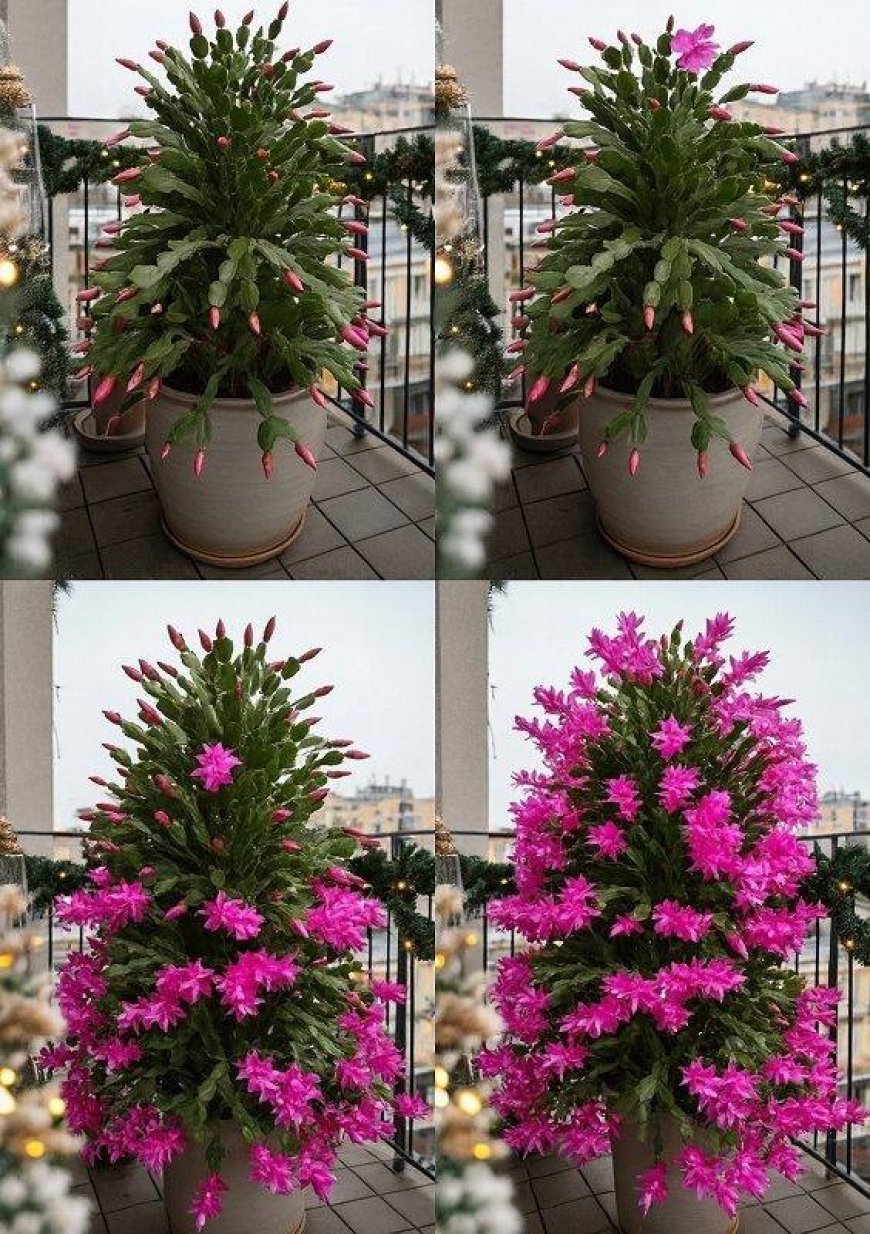The Christmas Cactus Secret – How I Accidentally Discovered Why Mine Suddenly Burst into Bloom!
For months, my Christmas cactus sat quietly on the windowsill — dull, lifeless, and completely unresponsive. I had almost given up on it, thinking it would never bloom again. It was a gift from my aunt years ago, who promised it would blossom every December like clockwork. But no matter what I did, it stayed stubbornly green. Then, one autumn evening, something unexpected happened — something that would completely change the way I cared for it. By pure accident, I discovered the hidden secret behind its beautiful blooms. What I learned that day not only revived my plant but also taught me a surprising lesson about patience, light, and the quiet magic of nature.
1.
I still remember the day I almost threw my Christmas cactus away. It sat there on the windowsill, looking sad and lifeless. For months, nothing had changed — no new leaves, no color, no sign of life. I had gotten it years ago from my aunt, who swore it bloomed every December like a little miracle. “You just have to understand it,” she told me with a smile. And I thought, how hard could that be?
But Christmas came, and the cactus stayed green. Easter came — still green. Even in summer, when everything else in the garden burst with life, it stubbornly remained the same. I was about to give up on it. And then something happened — something I later called my little botanical miracle.
It was a gray evening in October. I had forgotten to open the blinds in the living room. For nearly two weeks, the cactus stood in almost complete darkness because I was barely home. One morning, when I finally let the light in, I couldn’t believe my eyes: tiny pink buds were everywhere! It was as if the plant had decided to teach me a lesson — patience, darkness, and cold were its secrets.
Since then, I’ve been obsessed with repeating this little miracle every year. And I promise you: once you understand how your Christmas cactus “thinks,” it will reward you each winter with a spectacular display of blossoms.
My Journey to Discovering the Blooming Secret
The first thing I had to learn was that the Christmas cactus is not a typical cactus. I always assumed it liked dry air, bright sun, and little water — just like its spiny desert relatives. But no, this one is different. It’s a tropical species from Brazil! A true rainforest plant. It loves humidity, shade, and mild temperatures. In its natural habitat, it doesn’t grow in the sand, but high up in trees, where moss and soil gather in the crooks of branches.
So, I changed everything. Instead of keeping it on a sunny windowsill, I moved it to a bright but shady spot — no direct sunlight, just indirect light, like in a tropical forest. And sure enough, within weeks, its leaves looked plumper, greener, and more vibrant.
Light, Temperature & the Magic of Darkness
Here’s what I learned: the Christmas cactus thrives on routine. But if you want it to bloom, you have to trick it a little. Its flowering isn’t determined by fertilizer or luck — it’s all about the rhythm of light and temperature.
In autumn, it needs a resting phase — its own kind of “sleep.” For about four weeks, it should be kept cooler (around 10–12°C / 50–54°F) and in near darkness. I usually place mine in the hallway, where it’s cool and quiet at night. Some people simply cover it with a dark box — and that works wonderfully, too.
During this phase, reduce watering significantly — just enough to prevent the soil from drying out completely. After three or four weeks, the magic begins: small buds start forming at the tips. That’s your signal to move it back into the light — but do not move it again afterward! That’s the most common mistake. Christmas cacti hate being disturbed after they start budding; any change in position or temperature, and they’ll drop all their buds in protest.
Watering Like in the Tropics
Eventually, I stopped treating it like a desert cactus. Instead, I water it generously — but only after the soil has completely dried out. Overwatering leads to root rot, while underwatering causes the buds to shrivel and fall off.
Here’s my trick: I place a shallow tray filled with pebbles and water under the pot. As the water evaporates, it creates humidity around the plant — a little tropical microclimate I picked up from a Brazilian gardening book.
Soil and Fertilizing – Less Is More
What surprised me most was discovering that, in nature, Christmas cacti grow on tree branches — not in heavy soil! So I mix cactus soil with a bit of orchid mix to keep it airy and well-draining.
After it blooms (usually in January or February), I give it a small dose of mild liquid fertilizer for flowering plants — nothing too strong. Then it rests again until spring, when the cycle begins anew.
My Personal Story with “Grandma Lisa’s Cactus”
Today, I have three Christmas cacti. The oldest one is called Grandma Lisa. She actually belonged to my grandmother, who received it as a gift in the 1980s. When she passed
away, I inherited the plant — or rather, what was left of it.
It was small, gray, and covered in dust. I almost threw it away, but then I remembered all those Christmas evenings when it bloomed so beautifully on her dresser — those bright pink flowers glowing in the candlelight like something magical.
So, I decided to save it. I cut off the dead segments, replanted the healthy ones in fresh soil, and talked to it almost every day — yes, really! I’m convinced that plants respond to attention. And sure enough, after a year, it came back to life. Today, it blooms every single year — as if Grandma herself were still here.
Colors, Scents & Small Miracles
When it blooms, my living room transforms. The flowers look like tiny trumpets — delicate yet radiant. Depending on the variety, they can be pink, fuchsia, orange, or white — a tropical firework in the middle of winter.
I love sitting beside it in the evening with a cup of tea, watching the blossoms slowly unfold. It’s almost meditative.
Once, a friend visited and said, “It looks like little angels are hanging from your cactus.” And somehow, that’s exactly what it feels like. Every bloom is a little gift.
Common Mistakes (and How to Avoid Them)
Too much sun — direct light causes the leaves to shrivel.
Too much water — root rot is deadly.
T.ap the p.hoto to v.iew the full r.ecipe.



























